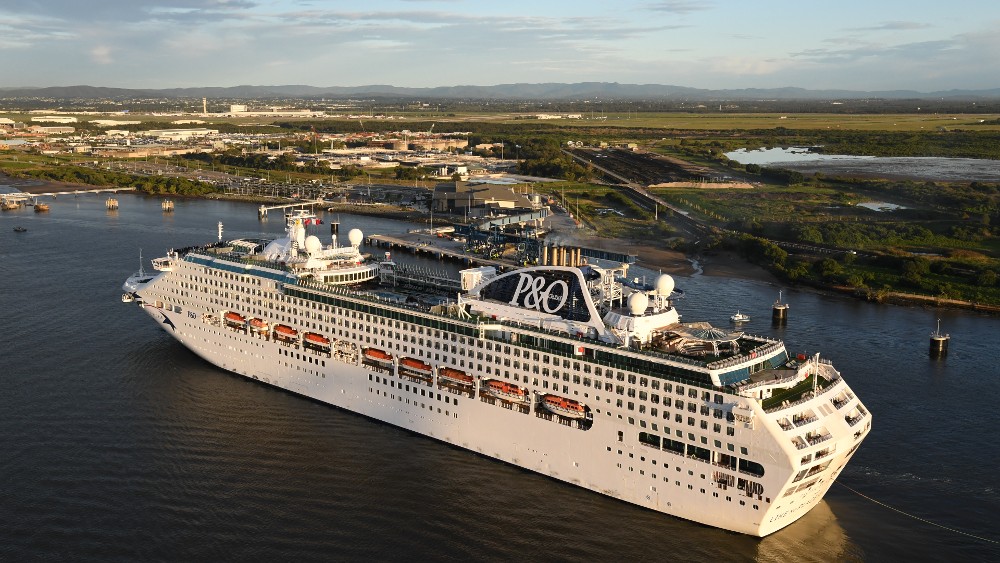Brian Crisp finds Brisbane’s new terminal was built to protect the environment from the start.
When P&O’s Pacific Explorer tied up at the brand new Brisbane International Cruise Terminal in June, it marked a major new beginning for Queensland’s push to grow its tourism industry.
Over the next 20 years, the terminal has the potential to triple the city’s cruise industry to support 3,750 jobs; bring more than 760,000 visitors annually and contribute $1.3 billion in net expenditure into the Brisbane economy.
“Sustainability underpinned many aspects of the new $177 million Brisbane International Cruise Terminal, funded and delivered by Port of Brisbane Pty Ltd,’’ Port of Brisbane CEO Neil Stephens said.
“Designed and developed in close consultation with our cruise line customers, the new terminal was required to support the cruise industry’s future growth including the cruise vessels larger than 270 metres which could not access existing upstream facilities.’’
Located at the mouth of the Brisbane River – adjacent to the Port of Brisbane’s main cargo port at Fisherman Island – the BICT can access existing marine infrastructure including naturally occurring deep water, swing basin and navigational channels.
The terminal incorporated sustainable design principles (developed collaboratively with the client’s lead designer, Arup and its architect, Arkhefield) that embrace Brisbane’s subtropical climate and lifestyle and improve sustainability.
“This included the site’s preparation and levels to ensure resilience to sea level rise and flooding as well as the building’s orientation, natural lighting and sun shading, which all work to maximise natural light and temperature moderation and improve user experience while reducing reliance on artificial energy sources and reduce pollution,’’ Mr Stephens said.
“Natural ventilation and ‘living greenery’ provide shade, cool public spaces and help reduce the ‘heat island’ effect of the terminal area.’’
The site’s location also removed the need for capital dredging during construction.
“The location can access existing marine infrastructure including naturally occurring deep water, swing basin and navigational channels. Port of Brisbane already undertakes routine maintenance dredging of its 90km navigational channel and swing basin (in accordance with permit conditions) to ensure safe access for commercial vessels. As the BICT shares the swing basin with the cargo port, there is no additional maintenance dredging required.”
The BICT project also focused on material re-use during construction.
“PBPL’s dredge vessel, the TSHD Brisbane, was utilised to place 300,000m3 of clean sand from existing channel maintenance dredging for BICT surcharging requirements. This surcharge was removed and re-used on other PBPL development projects. We also used dredge material as fill at the BICT site, elevating the site to achieve appropriate levels and creating a stable base for the development,’’ Mr Stephens said.
“The development of the site included rehabilitation and enhancement of nearby marine vegetation, with results demonstrating significant biodiversity improvement in these habitat areas.
The BICT is supported by PBPL’s existing extensive Environmental Management Plan which is certified to ISO14001 – every year we undertake 20 environmental programs, of which 15 are voluntary. This includes monitoring for air and water quality as well as seagrass and mangrove health to name a few.”
From an energy perspective, future energy integration has been incorporated into the base design, such as photovoltaic panels and battery storage, as has possible solar harvesting integration.
Currently, the BICT does not include shore power, however it is actively investigating opportunities with cruise line partners and supports them in their sustainability initiatives – such as reducing their own emissions.
“As part of the BICT’s construction and to support its ongoing operations, an 800kW solar system provides shaded carparking for passengers, while generating 1300MWh power annually and reducing the energy draw from the grid,’’ Mr Stephen’s said.
“Once the BICT is fully operational, it will provide all daytime power demand for the BICT’s operations whilst supporting other PBPL-managed buildings. We have also installed four electric vehicle charging stations within one of the public car parks.’’
BICT is also ticking boxes when it comes to technology infrastructure that supports growth, flexibility, and cyber security.
“The greenfield site enabled PBPL to consider digital trends including software defined networking, digital sensors, building information modelling and data automation while the technology infrastructure in place considers current and future requirements of cruise lines and border agencies systems and processes,’’ Mr Stephens said.
“As a tourism gateway, we understand first impressions are important which is why we established a new environmental partnership with local organisation Ocean Crusaders to trial and now permanently deploy its Tying up to to remove litter that deposits along the BICT seawall.’’









Does anyone know where Quantum of the seas will be docking in Brisbane.
I concur with the previous comments.
I post cruise information on my YouTube channel Jules Cruise Companion including my experiences at BICT, parking and transport access options.
As a serial cruiser I was disappointed in June 2022 to drive through industrial waste lands and piles of waste.
Industry is important for the economy but as the gateway to the cruise tourism industry it is not endearing.
The road infrastructure was poor. With the 2 years of COVID and delay on opening the BICT there was a window of opportunity that was missed to upgrade the roads.
The lack of public transport undermines the intent of low environmental impact.
At Portside, crew could buy items from the 7/11 and eat at the restaurants. Now they have the prospect of an expensive taxi if they want to go anywhere or get personal supplies.
I found over this first few months taxi’s are reluctant to go to the BCIT because they won’t get a fare in return and it is 25 to 30 minutes back to the airport for another fare.
The Wilson car park with it’s 3 sections at various prices has flexibility on a cruise day. Though I have been told the main access road it padlocked on non- cruise days. I would like this clarified as I would not want to be caught out on a one-way cruise with not being able to access my car. For example, after I flew back to Brisbane and caught a taxi to the Wilson car park at BICT could i get access to my car.
One cruise recently, I parked at the airport and taxied to the cruise terminal to avoid being potentially locked out of my car.
Maybe information on the BICT and Wilson’s website could clarify this point.
With the first cruises being domestic testing the facility, the itineraries to BICT will take on a significant shift with arrival of the first international itineraries. Public transport infrastructure needs to be in place and tested before then.
Stay Safe & Happy Travels
Due to the distance to Brisbane from the ship, it would make sense for them to use the tenders to transport passengers to South Bank or Hamilton Jetty. Maybe not with luggage, but as a day trip like when you go to Arley Beach or other ports where you need to other ports where docking is not possible.
It would b nice if Brisbane Cruise Terminal had a decent and reliable method of public or a CHEAP mode of transport out there past the SEWAGE pits and bush track to get there to make it easier for ALL people especially the CREW to get to and from the real life of the CITY.
Transport to and from the passenger terminal leaves a lot to b desired. DONT COUNCIL AND OTHERS have any BRAINS for their Ideas when they have these BRIGHT SPARK IDEAS. THINK ABOUT THESE THINGS.